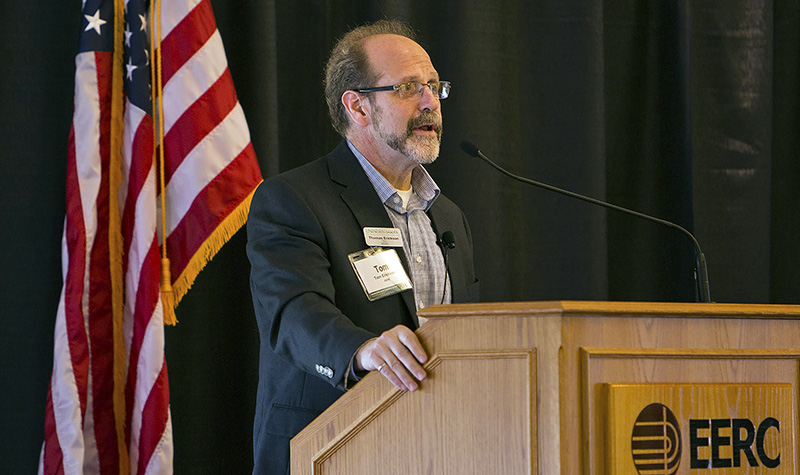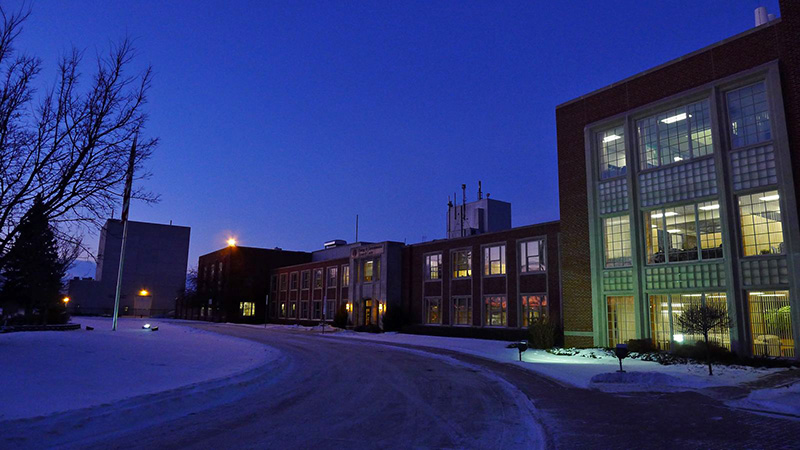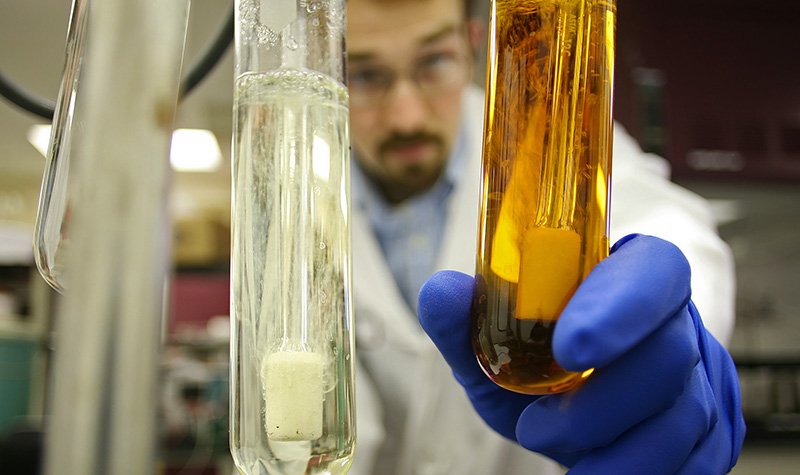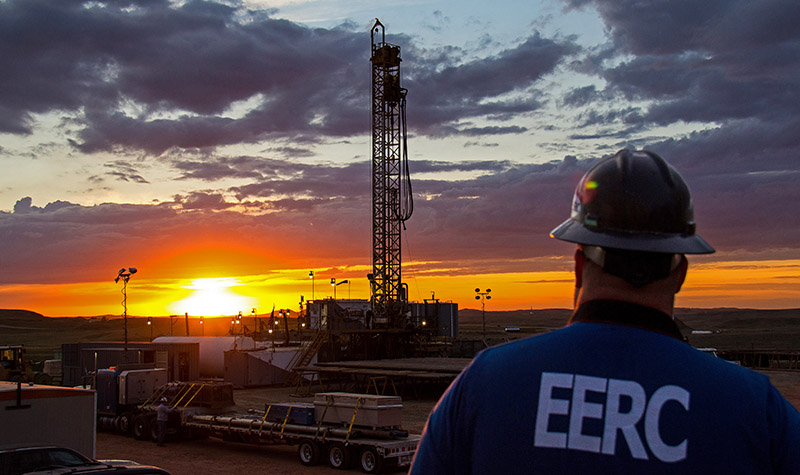11 Jun UND Director Tom Erickson to lead new State Energy Research Center

On Tuesday, Tom Erickson, CEO of UND’s Energy & Environmental Research Center (EERC), announced his transition to lead the new State Energy Research Center of North Dakota. Photo by Kari Suedel/EERC.
Nearly five years after being appointed to head UND’s Energy & Environmental Research Center (EERC), CEO Tom Erickson is transitioning to a new opportunity – leader of the new State Energy Research Center (SERC) of North Dakota.
The announcement was made Tuesday morning during a staff meeting at the EERC. In an email to employees, Erickson said, “I feel it is the right time for me, and honestly, the right time for the EERC to transition to a new CEO. I will continue to fill the role as CEO until a new person has been named. I am extremely excited to transition to the SERC, as well as to other duties supporting EERC’s researchers and management team.”
Tom DiLorenzo, UND vice president for academic affairs and provost, said, “It has been an absolute privilege and honor to work with Tom over the past five years. He has been a partner in every sense of the word working hard to build the EERC and to forge deep relationships with the rest of UND. Everyone who has met Tom in Grand Forks, across North Dakota and around the world knows that he is an outstanding leader, an honorable and ethical human being, a concerned manager and a faithful employee. I will miss working with him in his current role and look forward to hearing about all the ways Tom will help the EERC and the State of North Dakota as the head of the Energy Center.”

Under legislation passed last April establishing North Dakota’s State Energy Research Center (SERC) which Erickson will lead, the new center is to operate from the EERC. Photo courtesy EERC.
Erickson, who noted that he began working on the SERC initiative almost as soon as he was named head of the EERC, said. “Five years ago, Provost DiLorenzo gave me the opportunity to lead the EERC, and now, once transitioned, I will have the opportunity to lead this new initiative.”
At the Tuesday meeting, DiLorenzo said he will lead a series of listening sessions with EERC employees and external stakeholders to gather input on finding Erickson’s replacement. This information will be used to decide the best path forward in selecting a new CEO for the EERC.
Transformational research
In April, the North Dakota Legislature passed a bill signed by Gov. Doug Burgum creating and funding SERC, which will operate from the EERC. The new center will receive $5 million per biennium to conduct exploratory, transformational and innovative research that advances future energy opportunities to benefit North Dakota’s economy and environment. Under the legislation, 1 percent of oil and gas production and oil extraction tax revenues are allocated to fund SERC.
SERC’s research is intended to facilitate the development and use of the state’s energy resources in a clean, efficient manner. The center will provide access to energy experts who provide timely scientific and engineering studies in support of North Dakota’s interests. In addition, SERC will engage in education and outreach activities related to energy resources.
“The SERC is an incredible opportunity to accelerate the EERC and I want to focus my time on it,” Erickson wrote in his email to employees. “I promise you that I will work, and fight, as hard at advancing the SERC as I have as CEO for you.”
UND roots
Erickson earned bachelor’s and master’s degrees from UND in chemical engineering. He began working at the EERC – then known as the UND Energy and Mineral Research Center – as a student in 1986 before being hired as a full-time research specialist in 1988. He has held the positions of research engineer, supervisor for analytical research, research manager and senior research manager.
From 1999 to 2011, Erickson was an associate director for research, focusing on the development of advanced power and fuels systems from fossil and renewable energy sources. In 2011, he became the EERC’s associate director for business, operations and intellectual property. In October 2014, he was named Center director by DiLorenzo.
Last week, University President Mark Kennedy presented Erickson with the UND President’s Medal, noting his accomplishment of helping the EERC attract millions of dollars annually in government and private research dollars to deal with energy and environmental challenges on the state, national and international levels. He also noted Erickson’s volunteer work with the Community Violence Intervention Center.

The EERC began in the 1950s as a federal research center focused on low-rank coal. After becoming part of UND, it has branched into other research areas, such as alternative fuels. Photo courtesy EERC.
In the 1950s, the EERC began as a federal research facility focused on low-rank coal. Since then, the Center has broadened its research scope to include a wide range of energy and environmental issues. Erickson has overseen efforts to address these issues through strategic initiatives focused on clean coal technologies, oil and gas industry technologies; carbon capture, use and storage; energy and water sustainability; air toxics and fine particulate control; water management strategies; global climate change; waste utilization, hydrogen technologies; and contaminant cleanup.
More about Erickson
During Erickson’s tenure at the EERC and under his leadership, the Center has developed and participated in numerous projects and collaborations to address energy and environmental challenges. For example, it formed the Plains CO2 Reduction Partnership (PCORP) funded by the U.S. Department of Energy, which includes five states, two Canadian provinces and several industry partners. Over a 16-year period, the EERC has become a leader in carbon capture, use and storage technologies aimed at countering climate change.

The rapid expansion of the oil and gas industry in the Bakken shale formation resulted in the EERC broadening its research into such areas as enhanced oil recovery, carbon dioxide storage and pipeline safety. Photo by Agustinus Zandy/EERC.
As a result of rapid expansion of the oil and gas industry in the Bakken shale formation, the EERC worked with industry and North Dakota state government on a variety of initiatives, including technologies to reduce flaring and enhanced oil recovery, which offers the potential to greatly improve the recovery rate of oil and gas resources. The Center is focused on maximizing the use of clean, efficient natural gas, as well as using it as a source of value-added products, such as petrochemicals and fertilizers.
The EERC has capitalized on synergies between the agriculture and energy sectors to advance technologies for ethanol and other biofuels. When pipeline safety emerged as a major issue in North Dakota, the EERC launched the Intelligent Pipeline Integrity Program (iPIPE) to explore emerging technologies.
The EERC has assisted in enhancing the reliability of the U.S. electrical grid and developing the next generation of coal-fired power plants to use North Dakota lignite coal in an efficient and environmentally friendly manner. The power plant of the future will be capable of providing rare-earth elements, carbon fiber and other high-value products to make better use of the state’s energy resources.
Finally, under Erickson’s leadership, the EERC has contributed to energy and environmental knowledge worldwide by developing outreach and education tools to better inform the public. At a recent U.S. Senate committee hearing on Capitol Hill, the EERC was singled out by Julio Friedman of the Center for Global Energy for being an exceptional example of building clear, robust and transparent partnerships to engage communities and stakeholders.


